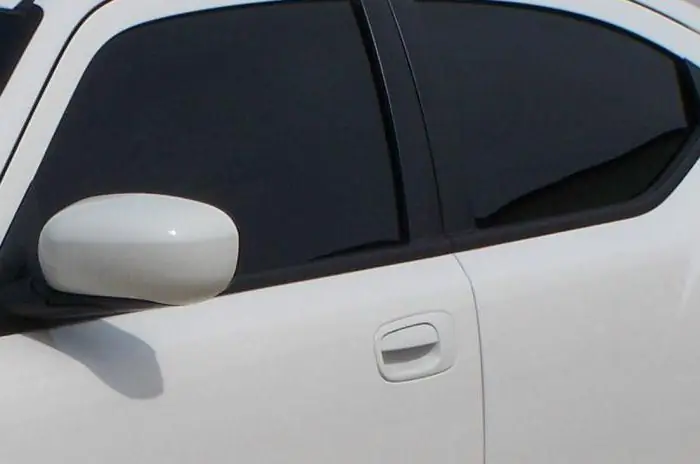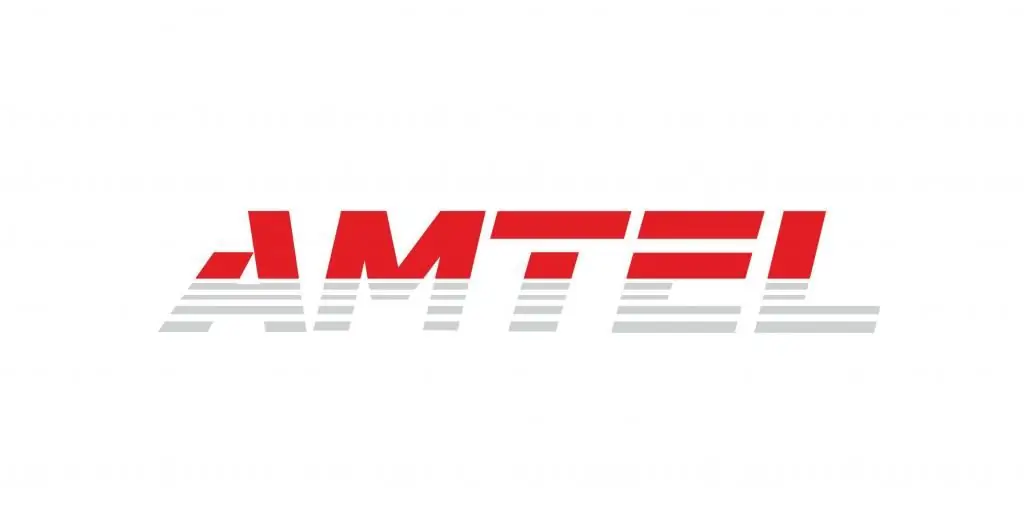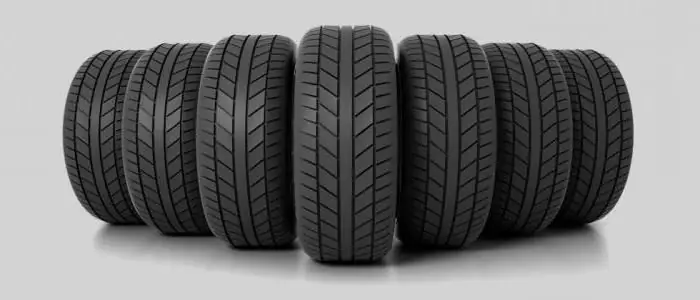2025 Author: Erin Ralphs | [email protected]. Last modified: 2025-01-22 21:14:09
One of the main components of the wheels of any car are pneumatic tires. They are mounted on the rim and provide high-quality contact with the road. When the vehicle is moving, the tire absorbs vibrations as well as vibrations from driving over bumps in the road. Thus, the tire provides comfort and safety. They make different types of tires. They differ in materials, chemical composition, physical properties. Tires have different tread patterns that provide maximum grip on various surfaces.
Tire Tasks
Pneumatic tires perform the following functions. They dampen vibrations from road bumps, ensure constant contact of the wheel with the roadway. Due to the tire, fuel consumption and noise level when driving are reduced. Rubber provides flotation in difficult conditions.
Device
The design of pneumatic tires is quite complex. The cover consists ofmultiple items.

This is a cord, tread, belt, shoulder area, sides and sidewalls. Consider each element in detail.
Cord
This element is a power frame. It consists of several layers. The cord is a layer of fabric made from textile materials or metal wire. This layer is covered with rubber. The cord is stretched over the entire area of the tire or radially. Manufacturers make radial as well as diagonal tire models.
The most widely used is the radial model. It has the longest lifespan. The radial tire has a more elastic cord. This significantly reduces heat generation and rolling resistance.
Diagonal pneumatic tires have a carcass made of several layers of rubberized cord fabric. These layers are arranged crosswise. These solutions have a low price, and the sidewalls are more durable.
Protector
This is called the outer part of the tire, which is in direct contact with the roadway. Its main function is to ensure reliable adhesion of the car wheel to the roadway, as well as protecting the wheel from possible damage. Noise, as well as vibrations during movement, depend on the pattern. In addition, the tread allows you to determine the degree of tire wear.

Structurally, this is a fairly massive rubber layer with a relief pattern. The latter is a groovegrooves, protrusions. The tread pattern determines the possibility of operating the tire in various conditions. There are models purely for asph alt or for dirt. There are also universal tires.
Tread patterns
It is formed on a rubber pneumatic tire by the arrangement of elements (checkers) relative to each other, as well as the direction of rotation. Different tires can have a non-directional, directional or asymmetrical pattern. Each option has an impact on tire performance.
The non-directional pattern wheel can be set arbitrarily. A tire with a directional tread is installed in the direction of the arrow on the sidewall. It shows the direction of rotation. Asymmetric tires are installed according to the inscription on the side.
The most versatile is the non-directional pattern. Some of the tires that are on the market today are produced with it. It allows you to install the tire on the wheel in any direction. However, at the same time, it is significantly inferior to other types of pattern in terms of the ability to drain water from the point of contact with the roadway.
The directional pattern features elements that are cut into a herringbone pattern. It requires a certain direction. This method of constructing a pattern makes it possible to more effectively remove water and dirt. Also, this pattern significantly reduces the noise level compared to non-directional. On the side part, the direction in which the wheel should rotate is necessarily indicated. The downside is that a spare wheel equipped with such a tire can beonly installed on one side of the car.

Asymmetric pattern is one of the options for implementing different properties in one tire. So, the outer side of the tread can have a pattern that provides maximum grip on dry pavement, and on the other side - with wet. Such a pattern is characterized by a different arrangement of checkers and grooves both on one and the other part from the middle of the tire. These tires are most often non-directional. Directed they are only in rare cases. In this situation, you need different tires for the left and right side. On the side parts there are necessarily symbols indicating which side should be external and which internal. A spare wheel with this tread pattern can be installed on the machine on either side.
Breker
It is a layer of cord that is between the tread and the carcass. The element is needed to ensure a better connection between the tread and the cord. The breaker also prevents the tread from peeling off due to various external forces.
Shoulder area
This is the part of the tread of pneumatic tires that is between the tread and the sidewall. This part serves to increase lateral rigidity. In addition, the structural element improves the synthesis of the tire carcass with the tread, the shoulder area takes part of the loads that are transmitted by the treadmill.
Sidewall
This is a rubber layer that is a continuation of the tire tread on the side of the carcass.

This partdesigned to protect the frame from moisture and various mechanical damage. Also marked on the sidewall.
Board
This is where the sidewall ends. The board is used for mounting and sealing on the rim. At the heart of the bead of a pneumatic car tire is an inextensible steel wire coated with rubber. It gives the tire and bead the necessary strength and rigidity.
Types of tires
The pneumatic tire of a car is classified according to various parameters. These are seasonality, sealing method, purpose, tread pattern. Consider each classification separately.
Seasonality
According to the season, tires are classified as follows - there are summer, winter and all-season tires. The purpose of the tire for one of the seasons is distinguished by the tread pattern.

Summer tires do not have a micro-pattern. But here there are pronounced furrows. They are designed to keep water running down them in wet weather. This makes it possible to obtain maximum grip. Winter tires have narrow tread grooves. Thanks to these grooves, the tire does not lose elasticity and keeps grip even on ice.
There are also all-weather tires. A lot has already been said about the advantages and disadvantages. These tires can withstand the heat of summer and the cold of winter. But the performance of all-season pneumatic tires is mediocre.
Sealing method
According to this parameter, tires with a tube andtubeless models. The latest tires do not have the usual chamber. And tightness is achieved due to the design features of such a tire. Both in the first and in the second case, these are tires with air.
Producers
The Italian brand Pirelli is especially popular with motorists. The company represents a lot of tire options for any cars and motorcycles. All tires are produced using unique technologies. The Pirelli Scorpion line shows itself well - the company presents winter and summer tires in this collection. The catalogs of the company have a lot of names for all cars. Tires for classic cars are also produced.

The Pirelli Scorpion line is tires for exclusive and premium cars. The product was developed taking into account modern cars. Also, the development took into account maximum safety, a high level of controllability and stable performance in any weather. Among the possibilities is that the tire can perform its functions even if there is no air in it. The collection contains all modern standard sizes.

Also, you can not discount other well-known companies that produce rubber for cars. Their products are not worse, and you can buy it at more affordable prices. When choosing tires, it is better to familiarize yourself with tire reviews in advance - a lot depends on the right choice of tires. Michelin, Continental and Nokian have proven themselves well. Among domestic it is worth noting "Rosava". Howreviews note, these tires are no worse than imported ones. And they cost almost half as much.
Conclusion
So, we have learned what a car tire is, how it works and what types it can be. This will help you choose the right model. Comfort, handling and safety depend on the right choice. An important factor when buying is tire reviews. They will allow you to evaluate the tire correctly, because sometimes, because of marketers, unpromising tires enter the market.
Recommended:
What is FLS: decoding, purpose, types, principle of operation, characteristics and application

This article is for those who don't know what FLS is. FLS - fuel level sensor - is installed in the fuel tank of a car to determine the amount of fuel inside the tank and how many kilometers it will last. How does the sensor work?
Types of car tinting. Car window tinting: types. Toning: types of films

Everyone knows that different types of tinting make the car more modern and stylish. In particular, dimming the windows in a car is the most popular and popular way of external tuning. The whole advantage of such modernization lies in its simplicity and relatively low cost of the procedure
Types of car tires by season, design, operating conditions. Types of car tire treads

Car tires are an integral part of any car, which seriously affects the grip and safety of the driver. It is very important to choose exactly the model that is suitable for your car and will meet all the requirements of the manufacturer. This article talks about the types of car tires (with photo), their marking and operating conditions
Amtel tires: types of tires, their features and owner reviews

Which Amtel tires are the most popular? What is the history of the presented brand? What is the opinion of domestic motorists about these tires? What results did the presented tires show during independent tests? What cars are these models suitable for?
"Toyo" - tires: reviews. Tires "Toyo Proxes SF2": reviews. Tires "Toyo" summer, winter, all-weather: reviews

Japanese tire manufacturer Toyo is one of the world's top sellers, with most Japanese vehicles sold as original equipment. Reviews about tires "Toyo" almost always differ in positive feedback from grateful car owners

